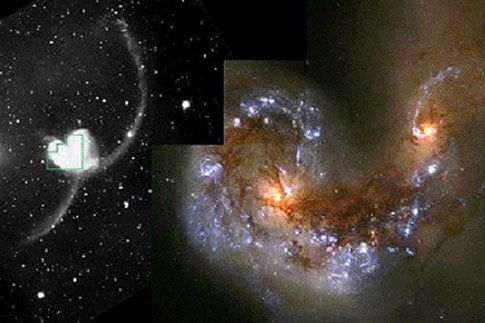A mere 24 light-years separate two supermassive black holes, says Cristina Rodriguez of the University of New Mexico (UNM) and the Simon Bolivar University in Venezuela. Astronomers used the Very Long Baseline Array (VLBA), 10 radio-telescope antennae that span more than 5,000 miles (8,000 kilometers) from Hawaii to St. Croix in the U.S. Virgin Islands to make the discovery during the most comprehensive survey to date of compact, radio-emitting objects. Their results will appear in a future issue of the Astrophysical Journal.
The black-hole pair — which lies about 750 million light-years distant in a galaxy known as 0402+379 and whose members orbit one another about every 150,000 years — may be the result of a galactic merger. “Astronomers have thought for a long time that close pairs of black holes should result from galaxy collisions,” says Rodriguez.
Scientists calculate the light-and-matter-gulping duo will collide in a billion-billion years. And when black holes collide, they hurl gravitational waves out into the universe. These disturbances in space-time’s curvature were first predicted in Einstein’s general theory of relativity. “Such black-hole collisions undoubtedly are important processes, and we need to find them,” says Gregory Taylor of UNM. Finding supermassive black-hole pairs in even more cramped quarters will reduce the time astronomers have to wait until a collision occurs and broaden the prospects of catching a merger in the act.
A joint NASA and European Space Agency space mission is getting under way to search for such gravitational waves and study black-hole mergers using the Laser Interferometer Space Antenna (LISA). LISA has a tentative launch date of 2015.










